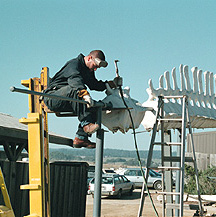![[Currents header graphic]](http://www.ucsc.edu/homeart/currents_header.gif)
![[Currents header graphic]](http://www.ucsc.edu/homeart/currents_header.gif)
November 23, 1998
By Tim Stephens
The 85-foot-long blue whale skeleton mounted beside the book and gift shop at UCSC's Long Marine Laboratory was dismantled last week in preparation for a trip to Florida, where it will be completely refurbished. The skeleton, which has delighted schoolchildren and other visitors to Long Marine Lab since 1987, will return in June for remounting in a new location next to the Marine Discovery Center now being built at the lab.

|
|
Pete Dal Ferro used a blowtorch to cut the metal scaffolding on which the whale's vertebrae were mounted. (more photos)
|
Staff at the lab began removing the huge skeleton from the metal scaffolding that held it together on Thursday. By the end of the day Friday the entire skeleton had been dismantled. The bones will be carefully packed into a truck for shipping to Homosassa, Florida. There, taxidermist Jesse Dobson will clean the skeleton, repair and replace any broken or missing pieces, and give the whole specimen a new protective coating.
"We've been planning to move the skeleton to a more prominent place for the Marine Discovery Center, so this is a good opportunity to have it refurbished and to make some replacement casts for the bones we were not able to collect," said Steve Davenport, assistant director of UCSC's Institute of Marine Sciences and manager of Long Marine Lab.
The blue whale skeleton has long been a popular attraction for visitors to the lab and is an integral part of the lab's public education programs. The skeleton was obtained from a female blue whale that died of unknown causes and washed ashore on Pescadero Beach in 1979.
Most of the whale's skeleton was recovered intact, but some of the bones were damaged or lost as the decomposing carcass rolled around in the surf, Davenport said. Dobson will create replacements for the missing pieces out of urethane, using special molding and casting techniques.
"The casts will be a different color so you will be able to tell the real bones from the cast pieces, but when you step back you will see it as a whole skeleton," Davenport said. "It's a lovely natural history specimen the way it is, and this will make it even more dramatic."
Dobson will also make molds of all of the bones, enabling him to cast reproductions of the entire skeleton. Dobson plans to market reproductions of the skeleton for $125,000 each. In return for the marketing rights, Dobson is charging a minimal fee for his restoration work, Davenport said. In addition, Long Marine Lab will receive 20 percent of any proceeds from the sale of reproductions.
"We're just happy to have found a way to do this for the modest amount we had budgeted for refurbishing the skeleton," Davenport said.
Dobson has already done several urethane casts of smaller bones in the lab's collections, said UCSC veterinarian Dave Casper. "He uses new casting methods and materials to get exquisite detail out of molds. He made a beautiful reproduction of a male elephant seal skull for us," Casper said.
Dobson's smaller casts are now being used for teaching purposes in UCSC biology classes. He will also be providing reproductions of killer whale skeletons for display in the Marine Discovery Center.
While Long Marine Lab's blue whale skeleton is in Florida, a substitute skeleton on loan from the Golden Gate National Recreation Area (GGNRA) will be displayed in its place. The GGNRA's skeleton is from a 72-foot male blue whale that washed ashore north of San Francisco in 1988. This skeleton is not in as good condition as Long Marine Lab's and will not be mounted, but the bones will be arranged in order on the ground. In addition, some of the bones from the GGNRA whale will be cast as replacement bones for the Long Marine Lab specimen.
"The whale skeleton has always been a very important interpretive tool for us, so we are glad to be able to borrow another one to use in our public education programs," Davenport said.
Construction of the Marine Discovery Center should be completed by the time the refurbished skeleton arrives back from Florida in June. Installation of the public aquarium and exhibits will just be getting started, Davenport said.
The Marine Discovery Center will house Long Marine Lab's highly successful research-based public education program. The center will include interactive research exhibits, classrooms, a marine biology teaching lab, an auditorium, teaching aquaria, a shark tank, a touch pool, and a book and gift shop. It is expected to open to the public in October 1999.
The Joseph M. Long Marine Laboratory is a marine research facility operated by UCSC's Institute of Marine Sciences. Its public education program, which serves more than 30,000 visitors each year, is unusual for a major university research facility. Trained volunteer docents lead tours for visitors, including students from schools throughout California. The lab offers professional development for K-12 science teachers and collaborates with local school districts and the Monterey Bay National Marine Sanctuary to develop sanctuary-based marine science curricula.